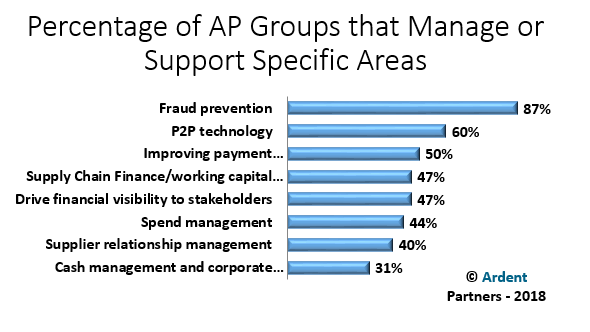There has long been a common misconception that all Accounts Payable does is pay bills. Anyone who works in AP or with knowledge of today’s AP function knows, nothing could be further from the truth. In Ardent Partner’s recent ‘State of ePayables 2018’ (click to download) research report, one of the things we set out to learn was what other specific duties/areas are managed or supported by today’s AP departments. Not surprisingly (at least to me), our research points to the continued evolution of AP and with it, an expansion of its reach into a broader scope of duties. Today’s AP teams are leveraging their diverse skill set to an ever increasing set of activities.
The chart below shows the specific areas managed or supported by a percentage of AP departments and just how prevalent AP’s expansion has been within the organization. Given the many areas listed and the relatively high percentage of AP groups involved with them, there is one clear fact to glean: the contemporary AP function is dynamic in nature and can support operations and impact performance in a variety of ways. This breadth of responsibility has been an unheralded aspect of just how valuable the AP department can be in relation to greater financial management objectives.

Let’s take a closer look at the top 3 ‘other’ areas of the business that today’s AP departments are actively managing or supporting.
Fraud Prevention (87%)
Accounts Payable sits in an ideal position to identify and flag potential instances of invoice and/or vendor payment fraud. Nearly 90% of AP functions today are actively managing or supporting fraud prevention efforts. Accounts Payable staff, via ePayables solutions or their own investigation, can detect possible fraud that is hidden amongst the steady stream of supplier transactions processed each month. Supplier verification, transaction patterns, checking for duplicate payments, rounded invoice figures, etc. all represent potential fraudulent activity and fall under the standard AP department’s purview. Accounts Payable’s relationship with financial and risk compliance has grown as well. AP is the perfect ally for compliance and risk management teams, and can assist in enforcing policies, identifying potential red flags, and escalating issues internally. Helping to prevent fraud is another source of value for AP.
Procure-to-Pay (P2P) Automation (60%)
Sixty percent (60%) of AP functions today support both AP and P2P automation. This figure shows AP and procurement departments, in general, continue to develop a more collaborative partnership. The proper management of these systems ensures that both procurement and AP processes run seamlessly, and serve as a unified platform to manage supplier transactions including requisitions and purchase orders, as well as how invoices are received, processed, and paid. Procure-to-Pay technology not only enables more streamlined AP processes, it also ensures that valuable financial data is in the hands of AP (and procurement) staffers who can transform it into enterprise intelligence.
Payment Management (50%)
The payment management process has been called the ‘last mile’, the ‘next frontier’, and the ‘future’ of AP. Call it whatever you like, the truth of the matter is that organizations are slowly, but surely, realizing the importance of B2B payments processing to the overall cash management strategy. Honestly, the only thing that surprises me here is that only 50% of the AP departments are currently managing the payments process. Invoice and payment processing are essentially two sides of the same coin. Organizations that harness the power of both AP automation and rigor on the payment side of the house can drive significant financial value.
Conclusion
AP’s broadening value to the organization isn’t limited to fraud, P2P automation, and payments. As you can see from the chart, AP is involved in many other functions such as supply chain finance (47%), working capital optimization (47%), spend management (44%), supplier relationship management (40%), and cash management (31%). As time goes by, I expect that these percentages will all increase as AP continues to show how it can add value across the board.
RELATED ARTICLES
Download the State of ePayables 2018 Report!
The State of ePayables 2018: The Expected Trajectory of AP – Part I
The State of ePayables 2018: What Makes the Best AP Departments Better?
Tagged in: AP Automation, Ardent Partners Research, ePayables, ePayables 2018, ePayments, Finance, P2P, Payables Place First Thing, People, Process, Technology









